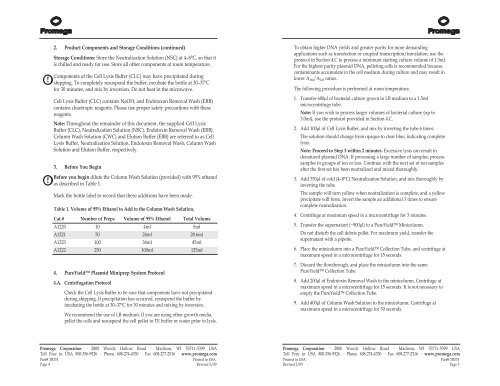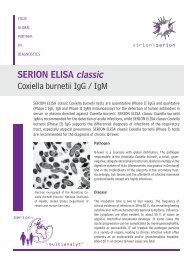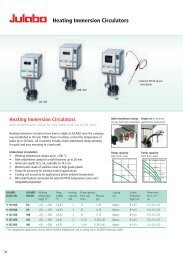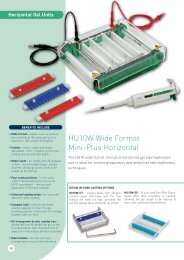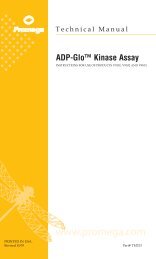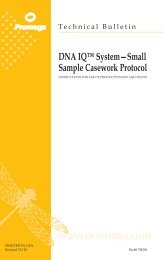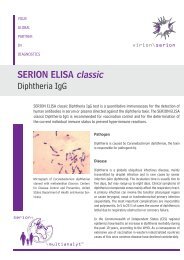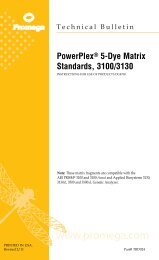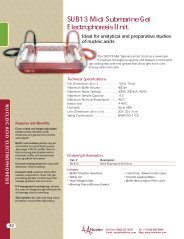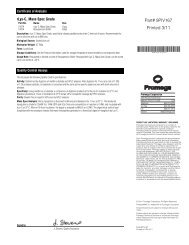Create successful ePaper yourself
Turn your PDF publications into a flip-book with our unique Google optimized e-Paper software.
!<br />
!<br />
2. Product Components and Storage Conditions (continued)<br />
Storage Conditions: Store the Neutralization Solution (NSC) at 4–8°C, so that it<br />
is chilled and ready for use. Store all other components at room temperature.<br />
Components of the Cell Lysis Buffer (CLC) may have precipitated during<br />
shipping. To completely resuspend the buffer, incubate the bottle at 30–37ºC<br />
for 30 minutes, and mix by inversion. Do not heat in the microwave.<br />
Cell Lysis Buffer (CLC) contains NaOH, and Endotoxon Removal Wash (ERB)<br />
contains chaotropic reagents. Please use proper safety precautions with these<br />
reagents.<br />
Note: Throughout the remainder of this document, the supplied Cell Lysis<br />
Buffer (CLC), Neutralization Solution (NSC), Endotoxin Removal Wash (ERB),<br />
Column Wash Solution (CWC) and Elution Buffer (EBB) are referred to as Cell<br />
Lysis Buffer, Neutralization Solution, Endotoxin Removal Wash, Column Wash<br />
Solution and Elution Buffer, respectively.<br />
3. Before You Begin<br />
Before you begin dilute the Column Wash Solution (provided) with 95% ethanol<br />
as described in Table 1.<br />
Mark the bottle label to record that these additions have been made.<br />
Table 1. Volume of 95% Ethanol to Add to the Column Wash Solution.<br />
Cat.# Number of Preps Volume of 95% Ethanol Total Volume<br />
A1220 10 4ml 5ml<br />
A1221 50 24ml 28.6ml<br />
A1223 100 36ml 45ml<br />
A1222 250 100ml 125ml<br />
4. PureYield <strong>Plasmid</strong> <strong>Miniprep</strong> <strong>System</strong> Protocol<br />
4.A. Centrifugation Protocol<br />
Check the Cell Lysis Buffer to be sure that components have not precipitated<br />
during shipping. If precipitation has occurred, resuspend the buffer by<br />
incubating the bottle at 30–37ºC for 30 minutes and mixing by inversion.<br />
We recommend the use of LB medium. If you are using other growth media,<br />
pellet the cells and resuspend the cell pellet in TE buffer or water prior to lysis.<br />
To obtain higher DNA yields and greater purity for more demanding<br />
applications such as transfection or coupled transcription/translation, use the<br />
protocol in Section 4.C to process a minimum starting culture volume of 1.5ml.<br />
For the highest purity plasmid DNA, pelleting cells is recommended because<br />
contaminants accumulate in the cell medium during culture and may result in<br />
lower A 260 /A 230 ratios.<br />
The following procedure is performed at room temperature.<br />
1. Transfer 600µl of bacterial culture grown in LB medium to a 1.5ml<br />
microcentrifuge tube.<br />
Note: If you wish to process larger volumes of bacterial culture (up to<br />
3.0ml), use the protocol provided in Section 4.C.<br />
2. Add 100µl of Cell Lysis Buffer, and mix by inverting the tube 6 times.<br />
The solution should change from opaque to clear blue, indicating complete<br />
lysis.<br />
Note: Proceed to Step 3 within 2 minutes. Excessive lysis can result in<br />
denatured plasmid DNA. If processing a large number of samples, process<br />
samples in groups of ten or less. Continue with the next set of ten samples<br />
after the first set has been neutralized and mixed thoroughly.<br />
3. Add 350µl of cold (4–8°C) Neutralization Solution, and mix thoroughly by<br />
inverting the tube.<br />
The sample will turn yellow when neutralization is complete, and a yellow<br />
precipitate will form. Invert the sample an additional 3 times to ensure<br />
complete neutralization.<br />
4. Centrifuge at maximum speed in a microcentrifuge for 3 minutes.<br />
5. Transfer the supernatant (~900µl) to a PureYield Minicolumn.<br />
Do not disturb the cell debris pellet. For maximum yield, transfer the<br />
supernatant with a pipette.<br />
6. Place the minicolumn into a PureYield Collection Tube, and centrifuge at<br />
maximum speed in a microcentrifuge for 15 seconds.<br />
7. Discard the flowthrough, and place the minicolumn into the same<br />
PureYield Collection Tube.<br />
8. Add 200µl of Endotoxin Removal Wash to the minicolumn. Centrifuge at<br />
maximum speed in a microcentrifuge for 15 seconds. It is not necessary to<br />
empty the PureYield Collection Tube.<br />
9. Add 400µl of Column Wash Solution to the minicolumn. Centrifuge at<br />
maximum speed in a microcentrifuge for 30 seconds.<br />
Promega Corporation · 2800 Woods Hollow Road · Madison, WI 53711-5399 USA<br />
Toll Free in USA 800-356-9526 · Phone 608-274-4330 · Fax 608-277-2516 · www.promega.com<br />
Part# TB374<br />
Printed in USA.<br />
Page 4 Revised 5/09<br />
Promega Corporation · 2800 Woods Hollow Road · Madison, WI 53711-5399 USA<br />
Toll Free in USA 800-356-9526 · Phone 608-274-4330 · Fax 608-277-2516 · www.promega.com<br />
Printed in USA.<br />
Part# TB374<br />
Revised 5/09 Page 5


